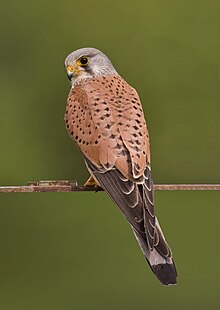
Back طيور جنوبية Arabic Australaves Spanish جنوبمرغان Persian Súdfûgels Frisian אוסטרלאווס HE Australaves Hungarian Australaves Italian 오스트레일리아조류 Korean Australaves NB Australaves Portuguese
| Australaves | |
|---|---|

| |
| Kestrel, Falco tinnunculus | |
| Scientific classification | |
| Domain: | Eukaryota |
| Kingdom: | Animalia |
| Phylum: | Chordata |
| Class: | Aves |
| Clade: | Telluraves |
| Clade: | Australaves Ericson, 2012 |
| Clades | |
Australaves is a clade of birds,[3] defined in 2012,[4] consisting of the Eufalconimorphae (passerines, parrots and falcons) as well as the Cariamiformes (including seriemas and the extinct "terror birds").[5] They appear to be the sister group of Afroaves.[5] This clade was defined in the PhyloCode by George Sangster and colleagues in 2022 as "the least inclusive crown clade containing Cariama cristata and Passer domesticus".[6]
The clade's name, meaning 'southern birds', reflects the group's evolutionary origins in the Southern Hemisphere: passerines and parrots in Australia, and falcons and seriemas in South America.[4]
As in the case of Afroaves, the most basal clades have predatory extant members, suggesting this was the ancestral lifestyle;[7] however, some researchers like Darren Naish are skeptical of this assessment, since some extinct representatives such as the herbivorous Strigogyps led other lifestyles.[8] Basal parrots and falcons are at any rate vaguely crow-like and probably omnivorous.[9]
| Australaves |
| ||||||||||||||||||
Cladogram of Telluraves relationships based on Kuhl et al. (2020) and Braun & Kimball (2021)[2][10]
- ^ Boles, Walter E. (1997). "Fossil songbirds (Passeriformes) from the Early Eocene of Australia". Emu. 97 (1): 43–50. Bibcode:1997EmuAO..97...43B. doi:10.1071/MU97004.
- ^ a b Kuhl, H.; Frankl-Vilches, C.; Bakker, A.; Mayr, G.; Nikolaus, G.; Boerno, S.T.; Klages, S.; Timmermann, B.; Gahr, M. (2021). "An unbiased molecular approach using 3′-UTRs resolves the avian family-level tree of life". Molecular Biology and Evolution. 38 (1): 108–127. doi:10.1093/molbev/msaa191. PMC 7783168. PMID 32781465.
- ^ Kimball RT, Wang N, Heimer-McGinn V, Ferguson C, Braun EL (2013). "Identifying localized biases in large datasets: A case study using the Avian Tree of Life". Molecular Phylogenetics and Evolution. 69 (3). Mol Phylogenet Evol: 1021–1032. Bibcode:2013MolPE..69.1021K. doi:10.1016/j.ympev.2013.05.029. PMID 23791948.
- ^ a b Ericson, P. G. (2012). "Evolution of terrestrial birds in three continents: biogeography and parallel radiations". Journal of Biogeography. 39 (5): 813–824. Bibcode:2012JBiog..39..813E. doi:10.1111/j.1365-2699.2011.02650.x. JSTOR 41496062. S2CID 85599747.
- ^ a b Prum, Richard O.; Berv, Jacob S.; Dornburg, Alex; Field, Daniel J.; Townsend, Jeffrey P.; Lemmon, Emily Moriarty; Lemmon, Alan R. (2015). "A comprehensive phylogeny of birds (Aves) using targeted next-generation DNA sequencing". Nature. 526 (7574): 569–573. Bibcode:2015Natur.526..569P. doi:10.1038/nature15697. ISSN 1476-4687. PMID 26444237. Retrieved 2024-07-23.
- ^ Sangster, George; Braun, Edward L.; Johansson, Ulf S.; Kimball, Rebecca T.; Mayr, Gerald; Suh, Alexander (2022-01-01). "Phylogenetic definitions for 25 higher-level clade names of birds" (PDF). Avian Research. 13: 100027. Bibcode:2022AvRes..1300027S. doi:10.1016/j.avrs.2022.100027. ISSN 2053-7166.
- ^ Jarvis, E. D.; Mirarab, S.; Aberer, A. J.; Li, B.; Houde, P.; et al. (2014). "Whole-genome analyses resolve early branches in the tree of life of modern birds" (PDF). Science. 346 (6215): 1320–1331. Bibcode:2014Sci...346.1320J. doi:10.1126/science.1253451. hdl:10072/67425. PMC 4405904. PMID 25504713. Archived from the original (PDF) on 2015-02-24. Retrieved 2015-08-29.
- ^ Mayr, Gerald; Richter, Gotthard (2011). "Exceptionally preserved plant parenchyma in the digestive tract indicates a herbivorous diet in the Middle Eocene bird Strigogyps sapea (Ameghinornithidae)". Paläontologische Zeitschrift. 85 (3): 303–307. Bibcode:2011PalZ...85..303M. doi:10.1007/s12542-010-0094-5. ISSN 0031-0220.
- ^ Martin, Larry D. (2010-12-15). "Paleogene avifauna of the Holarctic". Vertebrata PalAsiatica. 48 (4): 367-374. ISSN 2096-9899.
- ^ Braun, Edward L.; Kimball, Rebecca T. (2021-01-05). "Data Types and the Phylogeny of Neoaves". Birds. 2 (1): 1–22. doi:10.3390/birds2010001. ISSN 2673-6004.
